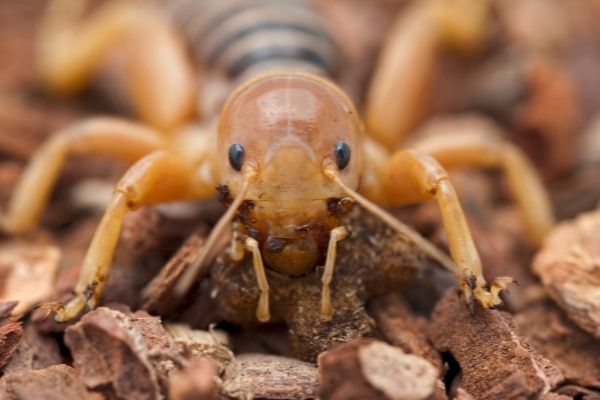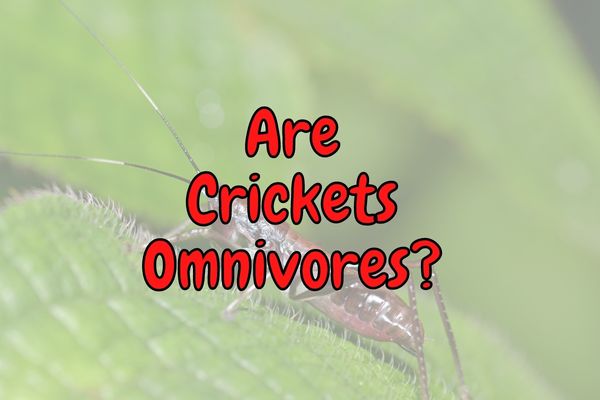Crickets are omnivorous insects that feed on a variety of plant and animal material. In the wild, crickets are important for recycling nutrients back into the ecosystem. Crickets mostly consume plants, including flowers, seeds, leaves, fruit, and grasses.
While they mostly eat plant material, they also eat dead or injured insects, as well as larvae, aphids, and other small invertebrates.
Because crickets mostly eat plant material, they are primarily classified as herbivores. However, they are not picky and they do have the ability to eat other animals as well, which does allow them to feed as omnivores and scavengers.
Crickets are opportunistic feeders and their diet changes depending on what is available. In the summer months they will eat more plants, while in the winter they will eat more insects.
As you will see in this post, crickets are one of the most diverse groups of animals when it comes to diet!
Primary Diet of the Cricket
Crickets live in grassy fields and forests. They are nocturnal, meaning they are awake at night and sleep during the day. Crickets eat a variety of foods, including plants, grains, larvae, dead or injured insects, aphids, flowers, seeds, leaves, fruit, and grass.
Crickets are omnivores, meaning they eat both plants and animals. Crickets primarily eat plants and grains, like wheat and oats, but when available they will eat larvae, dead or injured insects, and aphids.
Some of the most common food items eaten by crickets are:
- Grass
- Wheat
- Barley
- Corn
- Sorghum
- Oats
- Milo
- Other insects
Feeding Habits and Digestion of the Cricket
Crickets eat plants, grains, larvae, dead or injured insects, and aphids by catching them with their front legs and chewing them up.
Crickets are insects that belong to the order Orthoptera and the suborder Ensifera. They are known for their distinct chirping sounds and are commonly found in grassy areas around the world. When it comes to their feeding habits and digestion, crickets are primarily herbivorous, although some species may also exhibit omnivorous tendencies.
Feeding Habits:
Most crickets feed on plant matter, including leaves, fruits, flowers, and seeds. They are considered generalist feeders, meaning they can consume a wide range of plant materials. Some cricket species are known to be scavengers and may also feed on decaying organic matter, fungi, and even dead insects. Occasionally, crickets may exhibit cannibalistic behavior, consuming other crickets, especially during periods of food scarcity.
Digestive System:
Crickets possess a relatively simple digestive system suited to their herbivorous diet. Here is a general overview of their digestion process:
- Mouthparts: Crickets have chewing mouthparts called mandibles, which they use to bite and grind their food.
- Ingestion: The cricket takes in food through its mouth, breaking it down into smaller pieces using its mandibles.
- Foregut: The food then enters the foregut, which includes the esophagus and crop. The crop acts as a temporary storage chamber for food.
- Midgut: From the crop, the food passes into the midgut, where most of the digestion and absorption take place. The midgut produces enzymes that help break down complex carbohydrates, proteins, and fats into smaller molecules.
- Hindgut: Next, the partially digested food moves into the hindgut, where water absorption occurs. The hindgut is also responsible for the reabsorption of nutrients and the formation of feces.
- Elimination: Waste materials, including undigested plant fibers and other indigestible components, are eliminated from the cricket’s body through the anus as fecal pellets.
It’s worth noting that some cricket species have evolved unique adaptations in their digestive system. For example, certain cricket species that consume tougher plant matter may possess specialized foregut structures, such as mandibular or pharyngeal teeth, to aid in food processing.
Overall, crickets have efficient digestive systems that allow them to extract nutrients from plant matter, enabling their survival and growth.
Are Crickets Carnivores, Herbivores or Omnivores?
Crickets are mainly herbivores but are technically omnivores because they eat plants and other animals.
The animals that crickets eat are mostly other insects, including aphids, caterpillars, flies, grasshoppers, moths, beetles, ants, bees, termites, wasps, dragonflies and even butterflies.
Their taste for meat does depend on the species and their habitat, and some crickets like the jerusalem cricket is a true omnivore with no main preference.
Jerusalem crickets, also known as weta, are a type of cricket that is native to New Zealand.

These crickets are unique in that they have no wings, and instead rely on their powerful legs to jump around. They are also known for their large size, with some individuals reaching up to 6 cm in length.
One of the most notable differences between Jerusalem crickets and other types of crickets is their diet.
While most crickets feed on plants or small insects, Jerusalem crickets are actually carnivorous and will prey on larger insects such as worms or slugs. This makes them beneficial to farmers, as they can help control pests.
Are Crickets Producers, Consumers or Decomposers?
Crickets are consumers because they eat other animals and plants. Crickets are omnivores, which mean they eat both plants and animals.
Crickets ability to eat dead insects allows them to act as detritivores, a type of decomposer, but their primary role is as primary consumers.
Jerusalem crickets will also eat dead organic matter in the soil, and can therefore also function as detritivores or decomposers!
What Type of Consumer is a Cricket?
A cricket is classified as a primary consumer, specifically an herbivore. In ecological terms, consumers are organisms that obtain energy by consuming other organisms or organic matter. Primary consumers are the herbivores that directly feed on plants or plant-based materials.
Crickets primarily feed on plant matter such as leaves, fruits, flowers, and seeds, making them herbivorous primary consumers.
They play an important role in ecosystems as they convert plant biomass into energy and nutrients that can be passed on to other organisms higher up in the food chain.
They serve as a food source for various predators, including birds, reptiles, amphibians, and other insects, making them an integral part of the food web.
Can Crickets be Considered Decomposers?
Yes, but it is not their primary mode of feeding. Whereas they do eat dead animals, and can therefore be regarded as scavengers or detritivores, they are not true decomposers as bacteria and fungi. These microorganisms live primarily of dead and decomposing matter.
Where are Crickets in the Food Chain?
Crickets occupy a specific position in the food chain, playing a vital role in the ecosystem. Crickets are secondary consumers because they eat other organisms.
Animals that only eat plants are primary consumers and are placed on the second trophic level in the energy pyramid.
To understand their place in the food chain, let’s explore the concept of trophic levels.
Trophic levels refer to the different levels of the food chain that represent the flow of energy and nutrients from one organism to another. There are typically four trophic levels:
- Producers (Autotrophs): Producers are the organisms at the base of the food chain. They can produce their own food through photosynthesis or chemosynthesis. In terrestrial ecosystems, plants are the primary producers as they convert sunlight, water, and carbon dioxide into energy-rich organic molecules.
- Primary Consumers (Herbivores): Primary consumers are herbivores that directly consume plant material. They obtain their energy by feeding on producers. In the case of crickets, they primarily feed on plant matter such as leaves, fruits, flowers, and seeds, making them herbivorous primary consumers. Crickets obtain their nutrition and energy by consuming plant biomass.
- Secondary Consumers (Carnivores/Omnivores): Secondary consumers are carnivores or omnivores that feed on primary consumers. They derive their energy by consuming other organisms. In the context of crickets, secondary consumers could include animals such as birds, reptiles, amphibians, and certain insect species that prey on crickets as a food source.
- Tertiary Consumers (Top Predators): Tertiary consumers are carnivores at the highest trophic level. They feed on secondary consumers, gaining energy by consuming other predators. Examples of tertiary consumers could include larger predators like snakes, mammals, or birds of prey that may consume secondary consumers that feed on crickets.
So, in the food chain, crickets occupy mostly the second trophic level as primary consumers, directly consuming plant material. They serve as an important link between the producers (plants) and the higher trophic levels, transferring energy and nutrients from plants to other organisms up the food chain.
Crickets also participate in detritivory and decomposition processes. Some cricket species may scavenge on decaying organic matter, dead insects, or even fecal matter, contributing to the breakdown and recycling of organic materials in the ecosystem.
This detritivorous behavior places them as decomposers or detritivores, further influencing nutrient cycling in the environment.
It’s important to note that the food chain is not a linear sequence but rather a complex network of interconnected relationships.
Organisms can occupy multiple trophic levels based on their feeding habits and the availability of resources. Additionally, there can be more trophic levels in certain ecosystems, involving quaternary consumers and beyond, depending on the complexity of the food web and the specific ecosystem dynamics.
Are Crickets Autotrophs or Heterotrophs?
Crickets are heterotrophs because they eat other living organisms. Practically no animals are autotrophic because animals do not get their energy directly from the sun like plants do. That is, animals like crickets cannot make their own energy!
What Animals Prey on Crickets?
Predators of crickets include birds, lizards, frogs, toads, spiders, wasps, dragonflies, centipedes, beetles, ants, mice and other small mammals.
Conclusion
In this post I have looked into the diet of crickets and how they are omnivores.
Crickets are a very common insects around the world. They can be found in gardens, parks and grassland, where they feed on grass, flowers and other smaller insects.
Crickets are also important in the agricultural and pet industry, because they cause a lot of crop damage and are used as food for birds and reptiles.
They are also a pest to other insects, so they are not all bad to have in your garden!
Crickets are omnivores, meaning they eat both plants and animals. They are also a very important part of the insect community.
Insects and other invertebrates are an important part of the food chain, and crickets are an important part of the food chain as well. Crickets, like many insects, are preyed on by birds. Birds such as owls, hawks, and owls hunt crickets and would not survive without them in some habitats.





